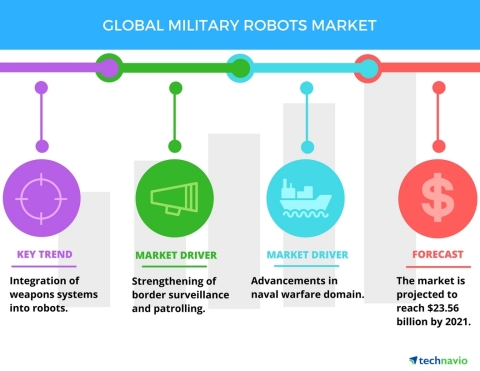LONDON--(BUSINESS WIRE)--Technavio’s latest market research report on the global military robots market provides an analysis of the most important trends expected to impact the market outlook from 2017-2021. Technavio defines an emerging trend as a factor that has the potential to significantly impact the market and contribute to its growth or decline.
The global military robots market is expected to post a CAGR of close to 12% during the forecast period. Military operations often involve challenges like remote and difficult-to-access terrains. They require advanced monitoring, targeting, and intelligence gathering mechanisms. In such a scenario, the usage of robots is gaining popularity, and this trend is expected to prevail over the next couple of years.
This report is available at a USD 1,000 discount for a limited time only: View market snapshot before purchasing
Buy 1 Technavio report and get the second for 50% off. Buy 2 Technavio reports and get the third for free.
The top three emerging market trends driving the global military robots market according to Technavio research analysts are:
- Development of multi-mission robots
- Integration of weapons systems into robots
- Development of humanoid robots
Looking for more information on this market? Request a free sample report
Technavio’s sample reports are free of charge and contain multiple sections of the report including the market size and forecast, drivers, challenges, trends, and more.
Development of multi-mission robots
Military robots are increasingly designed to carry out multiple missions. Advances in technology and miniaturization of electronic components have made operational flexibility in robots a reality. Unlike humans, robots do not suffer physical and mental exhaustion. They are designed for greater endurance from the impact of bombs and weapons.
The present-day robots are thus equipped with mission-specific modules and munitions to enable a variety of tasks. The payloads that these robots carry may be integrated in line with the mission requirements. For instance, radio frequency devices are used in robotic ground vehicles to enable convoy operations. Tele-operated robotic arms are fitted in robots for bomb disposal. Other payloads that are carried by robots include sensors, manipulators, cameras, computer displays, radars, munitions, etc.
“These robots can perform a wide range of missions like ISR, explosive ordinance disposal, and special weapons and tactics. These robots can perform bomb disposal, counter mine missions, and conduct reconnaissance and surveillance. They have abilities for precision pointing and capturing of high-definition data,” says Moutushi Saha, a lead analyst at Technavio for defense research.
Integration of weapons systems into robots
One of the crucial applications with respect to robots is weapons delivery. Robots are being developed to carry different payloads as per mission requirements such as grenades, missiles, and machine guns. The intent of using combat robots is basically to perform precision war fighting. With technological advances, it has become possible to program robots for very accurate deployment of weapons, which may not be possible for soldiers.
Another recent advance in weapon systems research is the prospect of laser weapons. It is anticipated that military drones may be armed with laser weapons in the future. Lasers may also be deployed at a faster rate and with greater precision. This technology may be able to counter an enemy object by melting it without causing an explosion.
Development of humanoid robots
Humanoid robots are being developed over the years for various applications. Countries such as Japan and China have extensively employed humanoids for manufacturing and service functions. The ultimate objective is to perform tasks faster and more accurately than humans. Moreover, robots can take up many tasks without physical and emotional downturns.
“Countries such as the US, Russia, and India have plans to use humanoids in their armies. These robots can mimic the abilities of soldiers and will be able to assist them in the future. Humanoids may initially operate under the guidance of a soldier and may evolve later to work autonomously. This is expected to bring down the number of casualties in war,” says Moutushi.
Browse Related Reports:
- Global Hypersonic Missiles Market 2017-2021
- Global Military Fighting Vehicles Market 2017-2021
- Global Counter Unmanned Aerial Vehicle (UAV) Defense System Market 2017-2021
About Technavio
Technavio is a leading global technology research and advisory company. Their research and analysis focuses on emerging market trends and provides actionable insights to help businesses identify market opportunities and develop effective strategies to optimize their market positions.
With over 500 specialized analysts, Technavio’s report library consists of more than 10,000 reports and counting, covering 800 technologies, spanning across 50 countries. Their client base consists of enterprises of all sizes, including more than 100 Fortune 500 companies. This growing client base relies on Technavio’s comprehensive coverage, extensive research, and actionable market insights to identify opportunities in existing and potential markets and assess their competitive positions within changing market scenarios.
If you are interested in more information, please contact our media team at media@technavio.com.




